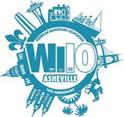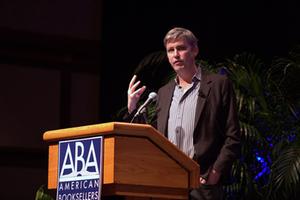 Drawing on examples of changes in technology that led to positive changes in society, Steven Johnson, author of How We Got to Now (Riverhead), encouraged independent booksellers to embrace new technologies, particularly all that the Internet offers. "They are not our enemy," he said. "They truly are our friends."
Drawing on examples of changes in technology that led to positive changes in society, Steven Johnson, author of How We Got to Now (Riverhead), encouraged independent booksellers to embrace new technologies, particularly all that the Internet offers. "They are not our enemy," he said. "They truly are our friends."
Speaking at the opening breakfast of the Winter Institute, Johnson first discussed the importance of his local bookstore when he was in high school. At the age of 15 and growing up in Washington, D.C., in the 1980s, he decided, he said, that he wanted to be a writer. "I wrote plays and poetry and imagined I'd be a novelist." ("My parents are still appalled I turned into science writer: they saw my high school biology grades.") He knew, he continued, that there was more to being a writer than "sitting at a typewriter" and that there were places writers went to sit and talk and debate each other's work. With his friends, in D.C., "we found our slice of the Left Bank in Dupont Circle at Kramerbooks & Afterwords. We'd hold court in the café for hours, pretending to be writers." (He was underage, he said, so "I was drinking Coke floats instead of absinthe, but it looked like absinthe.")
 |
|
| Steven Johnston Photo: Kevin Mann |
|
Thanking the store, he said, "I'm here in part because Kramerbooks gave me the space for someone like me to figure out how to become me."
Johnson discussed a range of inventions and approaches that unintentionally changed the course of history and might inspire booksellers to think in different ways and embrace change:
The concentration of glassmakers on the island of Murano near Venice in the 13th century led to "new ideas and new innovations" that spread through the community at ever fast rates, he said. The key result of this was the development of clear glass, which in an unforeseen way led to the invention of telescopes (Galileo quickly overturned "thousands of years of astronomical mistakes" with one) and microscopes (which led to the discovery of cells and the foundation of modern medicine and science) and widespread use of spectacles, which became necessary as reading spread following the invention of the printing press.
The 18th-century coffee houses in London, Paris, Vienna and, to a lesser extent, Boston and Philadelphia--where newly available coffee and tea supplanted the widespread use of alcohol as the main daily beverage for the population--was "where history was made," Johnson said. Those coffee houses are credited with leading to everything from the Age of Enlightenment to modern maritime insurance.
This happened because, Johnson said, the 18th-century coffee house was a "multiple disciplinary space defined by the collision of many different interests and ideas and passions." Such "diversity" leads to "smarter and more original thinking." It was a kind of "liquid network" that has properties similar to "what makes indie bookstores magical," he continued, places where people find thing they weren't looking for and meet people who both share interests and have other interests.
The invention of the first flash for photography (really an explosion) allowed Jacob Riis to photograph the horrid conditions in Manhattan tenements in the late 19th century (which led to his powerful book How the Other Half Lives and the progressive movement). Before he found out about the flash, Riis had been frustrated because his prose descriptions and line drawings didn't convey "the atrocity of the conditions." By embracing a new technology, however, Riis was able to make his mark. Johnson commented: "Sometimes we feel technology drives us, that we're being steered inexorably by machines or Mark Zuckerberg or Silicon Valley, as though we have no choice. Riis's story is a corrective to that idea."
Clarence Birdseye invented flash freezing technology because of his intense curiosity. When ice fishing with Inuits in Labrador in the winter of 1913, he noticed that the fish he caught froze immediately--and tasted much better than the kind of frozen food available at the time. But, Johnson stressed, instead of saying something like, "That tasted good. I'm going to bed," Birdseye experimented and figured out that quickly freezing food at low temperatures did the least amount of cellular damage (which made it taste better). He eventually figured out how to flash freeze on an industrial scale, and his company became the core of General Foods.
Johnson added that he hoped booksellers "approach the revolution of our moment" with the same kind of curiosity, enthusiasm and lack of fear as Birdseye did.
The development of Apple stores took as their inspiration not other consumer electronic stores (a normal company would have wanted to use them as a model and make their own stores "a little bit better") but from the Ritz-Carlton's emphasis on concierge services. That emphasis led to the creation of the Genius Bar, and by taking "a convention" from another industry and adapting it to a different one, Apple created "the most profitable retail store on the planet."
Finally Johnson talked about the effect of the Internet, noting that 20 years ago, when the Internet became widespread, futurists predicted that it would have a negative effect on cities and downtowns since everyone "could live on a ranch and order all books and CDs online." Declining inner cities would decline further. But "what happened was the opposite." The Internet made denser communities--and particularly restaurants and coffee shops and indie stores--more interesting. "The Internet helps you find and connect with people and meet up." And "nothing represents downtown values better than indie bookstores," Johnson continued. "They are spaces where ideas collide, surprises happen. You are all engines of curiosity." The Internet, he emphasized, is "an extraordinary opportunity for you." --John Mutter

